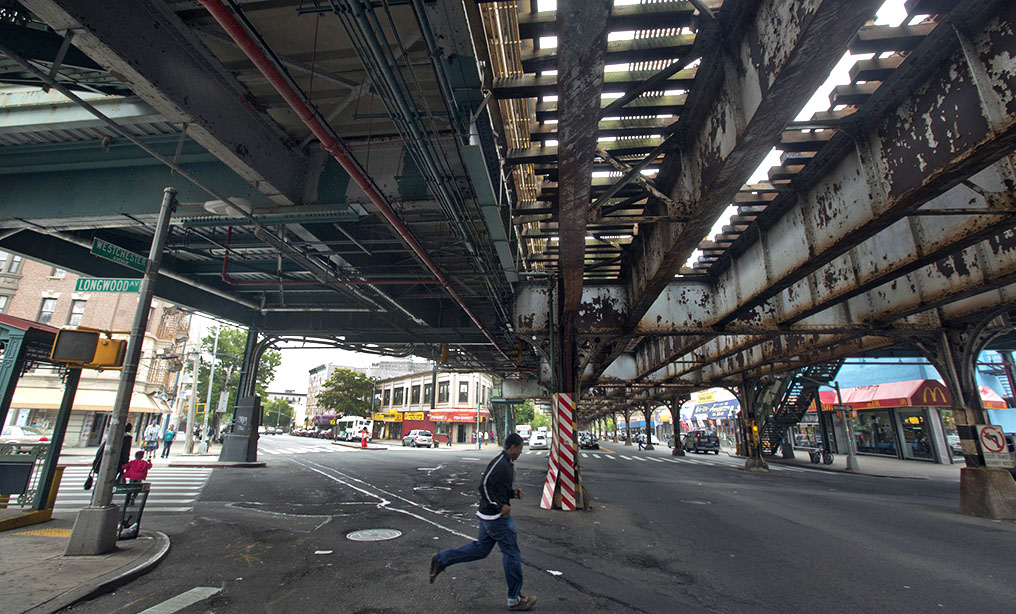Jury Awards $110M to Bicyclist Whose Spinal Cord Was Severed by 10-Foot Railroad Tie
The all-female jury awarded paraplegic Robert Liciaga more than $110 million, one of the highest awards his attorneys could find on record. The Metropolitan Transportation Authority is calling the verdict "grossly excessive."
April 10, 2019 at 04:58 PM
3 minute read
 An elevated section of subway tracks (AP Photo/Richard Drew)
An elevated section of subway tracks (AP Photo/Richard Drew)
A jury on Tuesday awarded just over $110 million to a 26-year-old paraplegic whose spinal cord was shattered by a 10-foot rail tie dislodged during a New York City Transit Authority track replacement project in Brooklyn.
The transit authority was found to be 100 percent liable for Robert Liciaga's injuries, which occurred three years ago today as he was riding a bicycle to a video game store in the Bushwick section, said his attorney, Scott Occhiogrosso, a partner at Block O'Toole & Murphy.
The transit authority was represented by the Syosset firm of Chesney, Nicholas, & Brower in Liciaga v. NYCTA, 513495, which was filed in 2016. While the firm did not respond to a request for comment, Metropolitan Transportation Authority Chief External Affairs Officer Maxwell Young issued a statement on the transit authority's behalf.
“This verdict is grossly excessive and we intend to pursue all avenues of appeal, in addition to asking the trial court to reduce the award,” he said.
Occhiogrosso and co-counsel Daniel O'Toole, a partner at Block O'Toole, offered the testimony of two expert witnesses who said that it would cost $40 million to care for Liciaga at a nursing facility for the rest of his life. The figure also accounts for the cost of medicine and rehabilitation.
The verdict included $60 million for pain and suffering and about $10 million for Liciaga's medical expenses over the past three years. The all-female jury gave the plaintiff almost exactly what his attorneys demanded. The attorneys believe it is one of the highest verdicts on record involving one plaintiff.
The plaintiff testified that he was told by a construction worker that it was safe to proceed west on Broadway under the elevated J and M where the track was being removed. He was unable to testify as to what happened next because he doesn't remember.
“His next conscious moment is that he's never going to walk again, he's never going to have bowel function again, he's never going to have bladder function again, he's never going to have sexual function again. And he's waking up to this and he's 23 years old,” Occhiogrosso said.
Occhiogrosso told the jury that he believed that as the barricades extended farther into the middle of busy Broadway, Liciaga felt safer riding to the right than to the left of them. He was able to do this because there was a 12-foot gap to make room for a payloader to clean up the railroad ties that were being dropped onto the street, Occhiogrosso said.
“There should have been a barricade line or wall directly in front of Robert so he would have no choice but go to his left and share the road,” his attorney said.
Liciaga's attorneys also argued that the area under the construction project should have been completely off-limits to bicyclists and pedestrians. If there had to be a gap, a guard should have been stationed there, Occhiogrosso said.
Kings County Supreme Court Justice Peter Sweeney informed the transit authority Tuesday that it has 60 days to move to set aside or reduce the $110,174,972.38 verdict.
This content has been archived. It is available through our partners, LexisNexis® and Bloomberg Law.
To view this content, please continue to their sites.
Not a Lexis Subscriber?
Subscribe Now
Not a Bloomberg Law Subscriber?
Subscribe Now
NOT FOR REPRINT
© 2025 ALM Global, LLC, All Rights Reserved. Request academic re-use from www.copyright.com. All other uses, submit a request to [email protected]. For more information visit Asset & Logo Licensing.
You Might Like
View All


Prosecutors Ask Judge to Question Charlie Javice Lawyer Over Alleged Conflict
Trending Stories
- 1How ‘Bilateral Tapping’ Can Help with Stress and Anxiety
- 2How Law Firms Can Make Business Services a Performance Champion
- 3'Digital Mindset': Hogan Lovells' New Global Managing Partner for Digitalization
- 4Silk Road Founder Ross Ulbricht Has New York Sentence Pardoned by Trump
- 5Settlement Allows Spouses of U.S. Citizens to Reopen Removal Proceedings
Who Got The Work
J. Brugh Lower of Gibbons has entered an appearance for industrial equipment supplier Devco Corporation in a pending trademark infringement lawsuit. The suit, accusing the defendant of selling knock-off Graco products, was filed Dec. 18 in New Jersey District Court by Rivkin Radler on behalf of Graco Inc. and Graco Minnesota. The case, assigned to U.S. District Judge Zahid N. Quraishi, is 3:24-cv-11294, Graco Inc. et al v. Devco Corporation.
Who Got The Work
Rebecca Maller-Stein and Kent A. Yalowitz of Arnold & Porter Kaye Scholer have entered their appearances for Hanaco Venture Capital and its executives, Lior Prosor and David Frankel, in a pending securities lawsuit. The action, filed on Dec. 24 in New York Southern District Court by Zell, Aron & Co. on behalf of Goldeneye Advisors, accuses the defendants of negligently and fraudulently managing the plaintiff's $1 million investment. The case, assigned to U.S. District Judge Vernon S. Broderick, is 1:24-cv-09918, Goldeneye Advisors, LLC v. Hanaco Venture Capital, Ltd. et al.
Who Got The Work
Attorneys from A&O Shearman has stepped in as defense counsel for Toronto-Dominion Bank and other defendants in a pending securities class action. The suit, filed Dec. 11 in New York Southern District Court by Bleichmar Fonti & Auld, accuses the defendants of concealing the bank's 'pervasive' deficiencies in regards to its compliance with the Bank Secrecy Act and the quality of its anti-money laundering controls. The case, assigned to U.S. District Judge Arun Subramanian, is 1:24-cv-09445, Gonzalez v. The Toronto-Dominion Bank et al.
Who Got The Work
Crown Castle International, a Pennsylvania company providing shared communications infrastructure, has turned to Luke D. Wolf of Gordon Rees Scully Mansukhani to fend off a pending breach-of-contract lawsuit. The court action, filed Nov. 25 in Michigan Eastern District Court by Hooper Hathaway PC on behalf of The Town Residences LLC, accuses Crown Castle of failing to transfer approximately $30,000 in utility payments from T-Mobile in breach of a roof-top lease and assignment agreement. The case, assigned to U.S. District Judge Susan K. Declercq, is 2:24-cv-13131, The Town Residences LLC v. T-Mobile US, Inc. et al.
Who Got The Work
Wilfred P. Coronato and Daniel M. Schwartz of McCarter & English have stepped in as defense counsel to Electrolux Home Products Inc. in a pending product liability lawsuit. The court action, filed Nov. 26 in New York Eastern District Court by Poulos Lopiccolo PC and Nagel Rice LLP on behalf of David Stern, alleges that the defendant's refrigerators’ drawers and shelving repeatedly break and fall apart within months after purchase. The case, assigned to U.S. District Judge Joan M. Azrack, is 2:24-cv-08204, Stern v. Electrolux Home Products, Inc.
Featured Firms
Law Offices of Gary Martin Hays & Associates, P.C.
(470) 294-1674
Law Offices of Mark E. Salomone
(857) 444-6468
Smith & Hassler
(713) 739-1250







